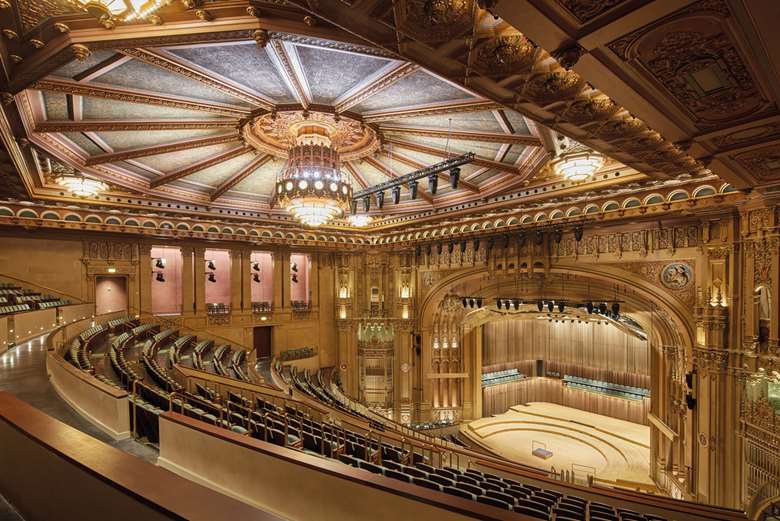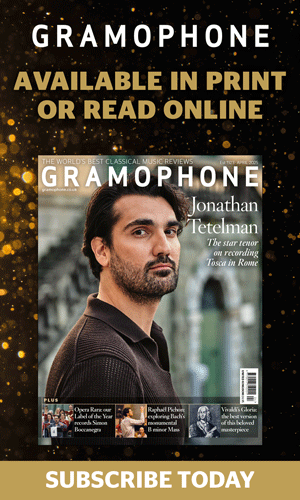Rebuild it and they will come: visiting San Diego’s Jacobs Music Center
James Jolly
Friday, February 21, 2025
A return to Southern California finds James Jolly in awe of the $125 million refurbishment of the downtown home of the San Diego Symphony Orchestra

If you travel down the West Coast of the United States, the last city you’ll reach before the border with Mexico is San Diego. Blessed with a perfect climate, it’s the country’s eighth largest city and a wealthy one too. A base for the US Navy has encouraged a large military and defence-related industry to thrive, as have, more recently, huge healthcare and bio-tech sectors. It’s also home to an orchestra that, were I a betting man, I’d wager is about to climb decisively up the league table of American ensembles, worthy to stand alongside its neighbours to the north, the Los Angeles Philharmonic and San Francisco Symphony. That it’s in such fine health is due in large measure to its President and CEO, Martha Gilmer, who has been at the orchestra’s helm since 2014 and to its Music Director, Rafael Payare, who has led the ensemble since 2019. Payare is an alumnus of Venezuela’s El Sistema, once a principal horn player in the Simón Bolívar orchestra and a former assistant to both Claudio Abbado and Daniel Barenboim. He is also the Music Director of the Montreal Symphony Orchestra, where his music-making, combined with his hyper-energetic and clearly very effective conducting style, is grabbing attention. Gilmer’s pedigree is also impressive, having come from 35 years with the Chicago Symphony Orchestra, where she served as Vice President for Artistic Planning and Audience Development. She has a huge amount of experience, a palpable love of music and clearly just gets things done.
I visited San Diego late in 2023 as a guest of the California Festival (of which Payare was one of the artistic heads). I heard the orchestra playing in its spectacular outdoor performing space The Rady Shell at Jacobs Park, and was taken on a hard-hat tour of the indoor concert hall, Jacobs Music Center, which was undergoing a $125 million renovation. ‘Come back when it’s finished,’ they said. And so I did. After all, there are few things more inspiring in these divisive times than hearing great music played in a glorious setting by a fine orchestra and an inspired conductor.
The San Diego Symphony was founded in 1910 (so older than the San Francisco and LA orchestras) and has had a slightly chequered career financially, with a number of periods of being disbanded. Since 1984, it has called the Jacobs Music Center home. Tucked under a fairly nondescript but very tall downtown skyscraper, Symphony Towers (complete with a 264-room hotel), the actual auditorium is quite breathtaking. Built in 1929, in Gothic Revival style, it opened as a Fox Theatre movie palace, and now has reclaimed – or, more likely, surpassed – its former glory.

Rafael Payare and Martha Gilmer – making magic in San Diego (Todd Rosenberg Photography)
For the revitalisation of the Jacobs Music Center, the number of seats was reduced: there are now 1823, and the sight lines are ideal. The colour of the interior (cafè latte with a touch of pink, perhaps) has an almost metallic sheen to it, and the blue green upholstery gives the space a wonderful sense of cool. Everything has been done to a high spec, and the overall effect is of a brand-new hall rather than a renovation. The blend of the old and the new (behind the proscenium arch, the effect is entirely contemporary) might serve as a metaphor for our classical music world – the traditional re-invented for a new age.
I chose my visit to coincide with one of Payare’s extended visits to San Diego, where he and his wife, the cellist Alisa Weilerstein, also have a home. The programme that I heard twice (first on a Friday morning and then on the Saturday evening) was the world premiere of a San Diego Symphony commission, Billy Childs’s Concerto for Orchestra, Prokofiev’s Piano Concerto No 3, with the young Russian Alexander Malofeev, and Beethoven’s Eroica. For variety it offered the perfect taster.
‘Even though it’s still the same place, the difference is huge’
Rafael PayareOver lunch, I asked Payare about the hall and how it has changed. ‘Even though it’s still the same place, the difference is huge. In reality, it’s a new sensation – everything feels different now. And we are still discovering things – we are only three months in and there are some things still that we can tweak, but the orchestra is starting to feel much more comfortable. And the musicians can hear each other now!’ The tuning sessions, during which the many variables offered by moving materials, adjusting screens, changing the angles of numerous acoustic panels and so on, have made an enormous difference. But the most radical move that Payare was prompted to make was to shift from a traditional US seating (first violins, seconds, violas and cellos, with basses behind the cellos) to a distribution more commonly encountered in Europe (first violins, cellos, violas, second violins, with the double basses on risers behind the firsts). ‘We tried this new seating, and did some Mahler, some Bruckner, some Richard Strauss, and I could immediately hear the string sound make a leap, and it was significantly for the better.’
Looking at the orchestra, which operates with a minimum of 82 players, is to be struck by how young many of the players are – and with youth comes an openness and willingness to experiment. ‘The orchestra have never played with split violins before – never,’ Payare continues. ‘First they found it slightly strange, but I asked my assistant conductor “Am I crazy, but do the strings sound way richer and much more layered?” We’d try various acoustic configurations with this seating – one had the brass blasting out, which was just wrong. But I feel the one we chose has given us sound on a completely different level. That’s why now we’re playing everything like that.’
My first sight of the hall was from what used to be the projection room for the old Fox movie theatre, a bird’s eye view from high up at the back. I entered the hall on a level with the very back row of the balcony while Malofeev was rehearsing the Prokofiev. The sound was rich, detailing very impressive and there was an ideal feeling of warmth offered by the reverberation. As Payare points out, the sound in the balcony was always good, but what the renovation has solved is the sound in the back of the stalls beneath the overhang. Previously the impact was hugely diminished, now it’s as clean, detailed and grounded as at the front.
One person who is highly sensitive to the hall’s acoustic is the orchestra’s Audio Director, Joel Watts, whom I met during my last visit to San Diego when he demonstrated the Meyer Sound system that gives the outdoor Rady Shell an impressive artificial ambience which allows not only an audience of thousands to hear with great clarity, but gives the players on stage a feeling that they are playing in a genuine acoustic. His domain is a brand-new control room built just behind the rear stalls, and kitted out with ATC speakers, Avid desks and three TV monitors, there’s a genuine sense of connection with the stage.
With new wooden staging that allows yards of microphone cabling to be hidden with minimal risk of tripping or snagging, and a suspended array of mics built around a ‘Decca Tree’ with outliers to give ambience for Dolby Atmos, the hall is almost a permanent recording studio. All of Payare’s concerts are recorded and even though the hall is still settling in, the sound is very impressive. I listened to the second Eroica from the control-room, and the bloom and warmth, coupled with great precision, made for a very satisfying experience.
It’s more or less a given that the world’s great ensembles are also the ones that record frequently. Of course, it’s a bit chicken-and-egg, but an orchestra that can listen to itself regularly is only going to get better. And Payare’s ear for internal balance is mighty impressive – the Eroica was perfectly judged, and it also demonstrated a very finely attuned ensemble (that they also play for San Diego Opera clearly does them no harm either). Joel Watts explained that ‘we’re hoping to set up the ability for all of our musicians to listen to the concerts that they do. So, whether we’re broadcasting them or not, they can come in and listen, but also on their phones going home. I mean, that’s what I do. I do my mix and when I’m driving home, or driving in the next day, I say “Well, why did I think that that was a good idea?” And then I’m going to come in and change these little things until it’s okay.’ Hopefully we’ll start to encounter the San Diego SO/Payare music-making on CD or streamed in the near future.
When Martha Gilmer, the orchestra’s CEO, walked out on stage for the Friday morning concert to welcome people, she asked who was there for the first time. As I gingerly raised my arm I was surprised that I was far from alone. ‘This is a build-back year,’ she later pointed out. ‘Of course, there’s the excitement of a new hall – that’s inevitable, and there’s always going to be a gap if you have to move out of your hall. And there was the pandemic, and with the hall closed we played in 14 different venues over the course of a year. But the word is out about the orchestra and Rafael. People are curious, and with the calibre of artists who are performing with us there’s real momentum.’ It was striking to witness a sold-out hall, despite statistics that revealed that the pandemic robbed the orchestra of quite a chunk of its patrons. That gap has clearly been filled – and judging by their enthusiasm after Malofeev’s thrilling Prokofiev, they really love their music!
San Diego has ‘one of the highest, and most successful, post-pandemic returns to tourism of any US city,’ Gilmer told me. ‘The numbers are really compelling. It’s a great place to visit for cultural tourism.’ Indeed it is, with a number of fine galleries in stunning buildings, as well as the city’s other musical gem, La Jolla’s gorgeous smaller venue, The Conrad, where I heard pianist Emanuel Ax and clarinettist Anthony McGill on my first night in town.
During my few days in San Diego the orchestra released its ’25-26 season plans and, as I said to Gilmer, someone clearly has their finger on the international musical pulse as some amazing, and very different, musicians would be visiting. Having two halls – the outdoor Rady Shell (usable for two thirds of the year) and the Jacobs Music Center – gives the SDSO an almost unique flexibility and, more important, has created two very loyal audiences. And while programming remains largely distinct, the Rady Shell audience loves the ‘Beethoven on the Bay’ and Tchaikovsky concerts, and inevitably some will find their way to the orchestra’s new hall. I’ve long believed that the confluence of great musicianship and a beautiful or architecturally striking setting can energise a city, and when there’s only one orchestra in town, the effect can really be transformative.










